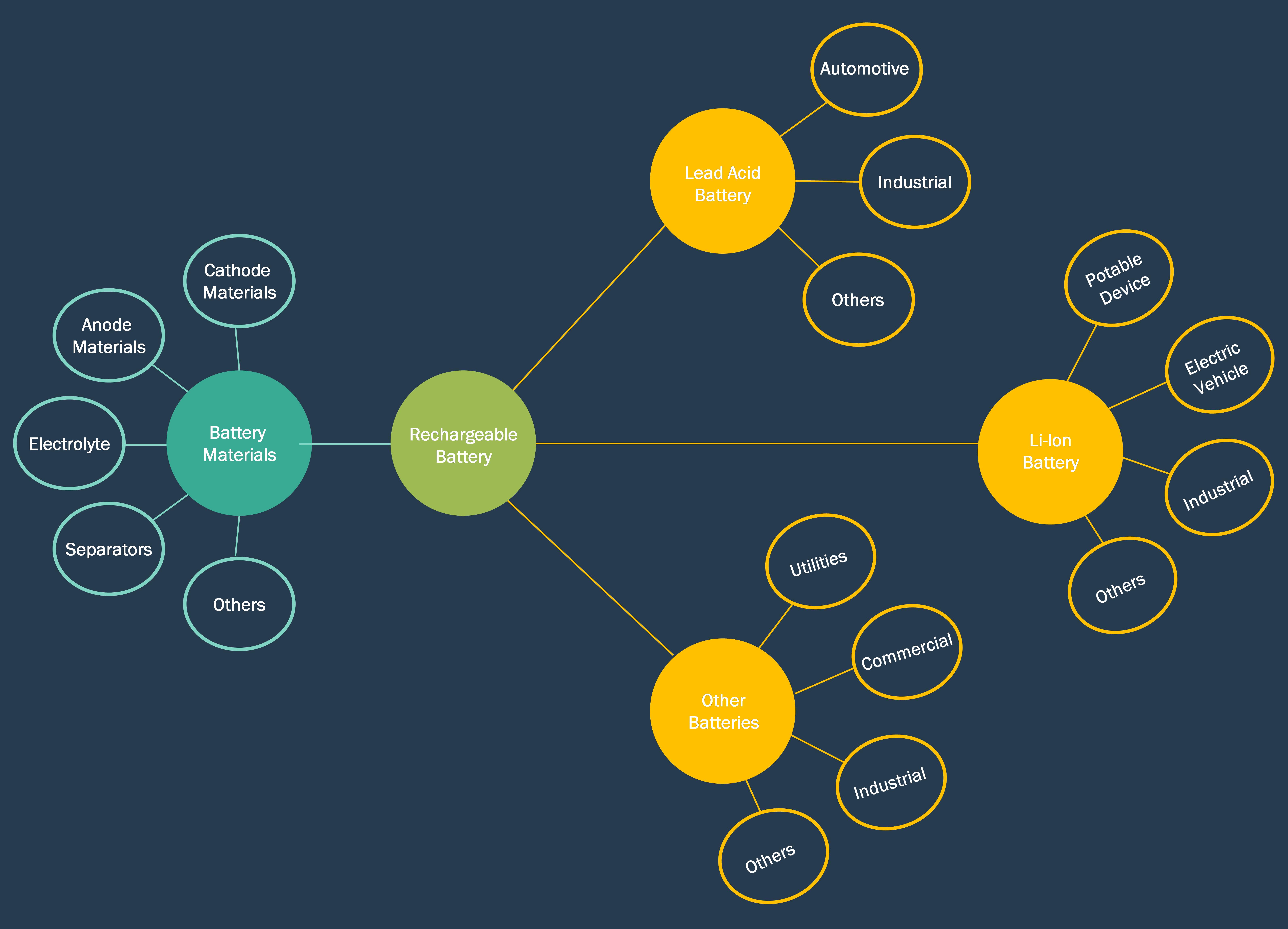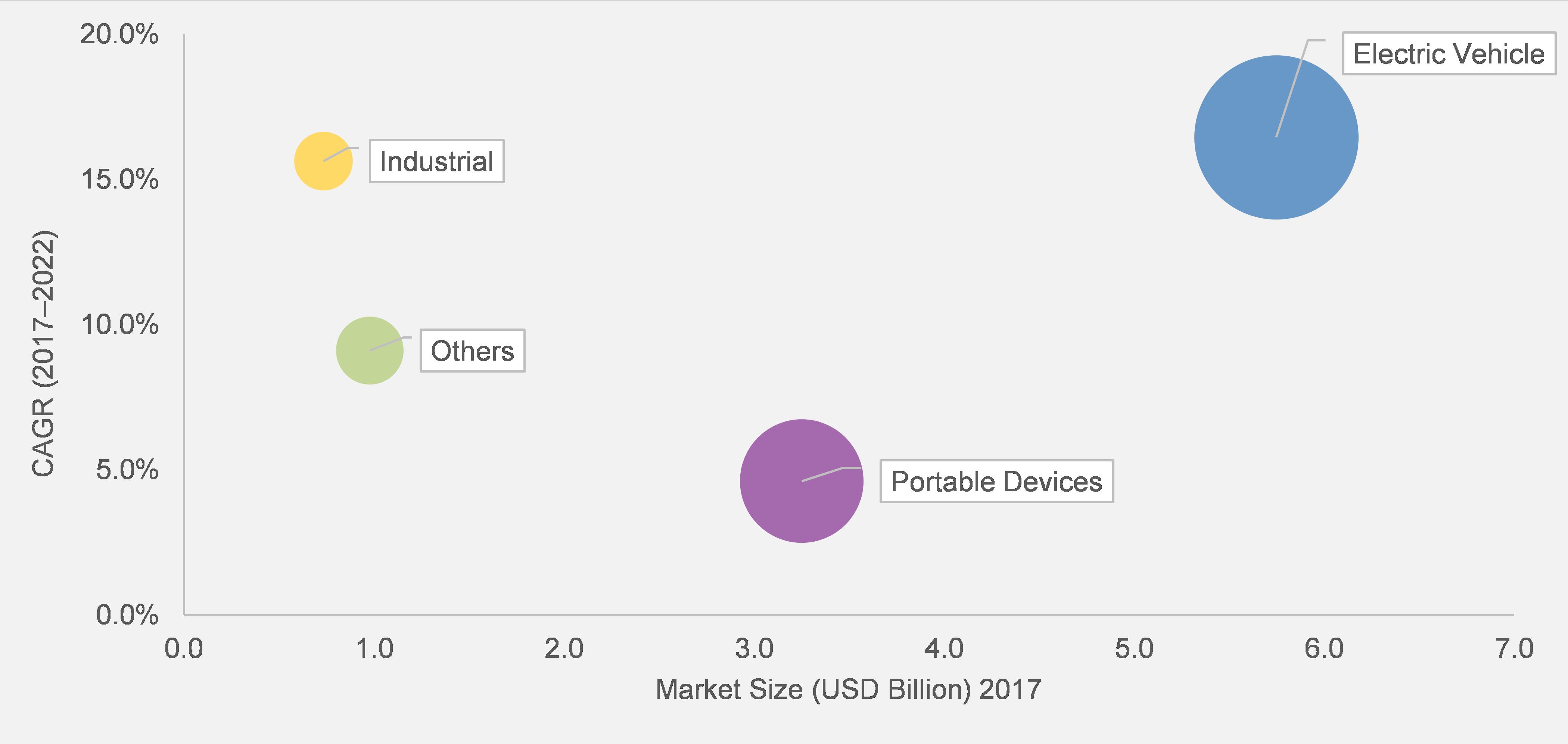Commentary Contributed by Atul Yadav, Senior Research Analyst, MarketsandMarkets Research Private Limited
June 23, 2018 | A battery is a device that transforms electro-chemical reactions into electric energy. There are basically two categories of batteries; primary and secondary. Primary batteries are non-rechargeable, whereas, secondary batteries are rechargeable. Lead-acid and lithium ion (Li-ion) batteries are the most widely used rechargeable batteries, accounting for approximately 95 percent of the global rechargeable battery market, and approximately 65 percent of the global battery market in terms of value. Other rechargeable batteries (sodium based, nickel-based, and flow battery) account for the remaining 5 percent of the global rechargeable battery market in terms of value. Most of the demand for these batteries is witnessed from automotive, portable devices, electric vehicles (EV), and industrial applications.
Cathode, anode, electrolyte, and separators are the building blocks of a battery. There are few other materials such as binders, current collector, and packaging materials that are also important parts of batteries. Different battery materials are used in the manufacturing of batteries.
The growth of the battery market is primarily driven by increasing demand for EVs, smart devices, automotive, and other electronics products. The demand for Li-ion batteries is growing faster than lead-acid in the global market. The growth of this market is propelled by the increasing demand for EVs, promotion of green technology, strict government mandates on fuel economy, growing demand for smart devices and other consumer electronics. Further, the reduction in the price of Li-ion batteries is also encouraging automobile manufacturers to invest more in EV manufacturing.

The automobile vertical is actively shifting toward the use of sustainable clean fuels. There is huge dependence on oil as a fuel in the transportation system of which almost 70 percent is being used in transport vehicles. This dependency has led to the rising concern among both environmentalists and economists. Increasing awareness about environmental concerns among people has led to the adoption of EVs. The widespread use of BEVs and PHEVs has inevitably led to the rising adoption of Li-ion batteries.
Increasing Development to Boost the Electric Vehicles Market
The automotive vertical comprises a number of companies involved in designing, manufacturing, developing, marketing, and selling automobiles. Continuous development in this vertical is supporting its growth. Owing to environmental concerns and awareness about clean and sustainable fuel, there is a rise in the demand for EVs. Government regulations and initiatives support the adoption of EVs around the world.
EVs are classified into various types depending on their applications and sources of power. Li-ion batteries are a critical part of EVs as the best source of power for meeting all EV requisites. The main types of EVs are BEVs and PHEVs. The implementation of Li-ion batteries in the automotive sector for PHEVs and BEVs helps to improve the efficiency and reduce the maintenance cost. There is increasing competition between battery models installed in EVs owing to the need for operational excellence. Various associations such as China Association of Automobile Manufacturers and Advanced Automotive Battery Conference have undertaken initiatives to increase the awareness regarding use and benefits of EVs and are helping to increase EV adoption rates. Increasing adoption of EVs supports the growth of the Li-ion battery market. Swift developments in Li-ion batteries and charging infrastructures play a positive role in the shift of consumers to EVs.

Government Supporting Green Initiative
The federal regulations of the US government prescribe the mandates on average fuel consumption for each automobile manufactured, which is to hit the mark of 18 kilometers per liter by 2020 and 23 kilometers per liter by 2025. Increasing pollution has affected major cities in the world. For example, the recent crisis faced by Delhi, India, due to the rising pollution has raised concerns, leading to various efforts being made by the government as well as NGOs. These efforts are driving the banning of combustion-driven cars by 2025.
Countries such as US, India, China, Germany, and Japan have been revising their energy policies to embrace a considerable portion of energy generation sourced from renewable energy resources that includes wind and solar. Financial support by government bodies and associated returns worldwide are increasing investments in renewable energy. Currently, renewable sources have become the preferred choice for expanding, upgrading, and modernizing power systems across the world. According to the Global Trends in Renewable Energy Investment 2017, published by UN Environment, the Frankfurt School-UNEP Collaborating Centre, and Bloomberg New Energy Finance, wind and solar energy accounted for 90 percent of the investments in renewable power in 2016. Renewable resources such as wind, solar, biomass and waste, geothermal, small hydro and marine comprehensively accounted for 55.3 percent of the overall gigawatts of new power generation worldwide last year.
Conclusion
The global demand for battery is majorly driven by APAC region. Heavy investment in automotive, EVs, electronics, and ESS is the key driving factor for the battery market. Government support, presence of strong manufacturing base, and growing investment by automotive giants for EVs production has made the region one of the leading battery industry across the globe. Many major OEMs have invested in the Indian market and production has inclined towards small and affordable passenger vehicles. South Korea is also witnessing considerable growth in the battery industry due to the global expansions of domestic brands’ and support from the government in the consumer electronics and automotive industries.
Continuous development strategies, such as organic and inorganic, adopted by leading players to expand their global presence and increase their market shares are expected to drive the battery market. Some of the leading companies are LG Chem., Ltd. (South Korea), Panasonic Corp. (Japan), Samsung SDI Co., Ltd. (South Korea), BYD Auto Co. Ltd. (China), and Shenzhen BAK Battery Co., Ltd. (China), Johnson Controls International (US), EnerSys (US), Aqua Metals Inc. (US), and many more players.
Technically proficient and result-driven professional, Atul has more four years of experience in the chemicals industry. He holds rich experience in technology, market research experience in the adhesive domain, and leads a cross-functional team of consultants for projects of major chemical companies with actionable insights. Most of his projects are in sales & marketing, business development, and strategic planning and implementation functions. Key consulting projects undertaken by him are distribution channel optimization, new product development, new market entry strategy, pricing strategy, growth strategy, identification of acquisition targets, and due diligence of targets.
Atul Yadav can be reached at atul.yadav@marketsandmarkets.com







